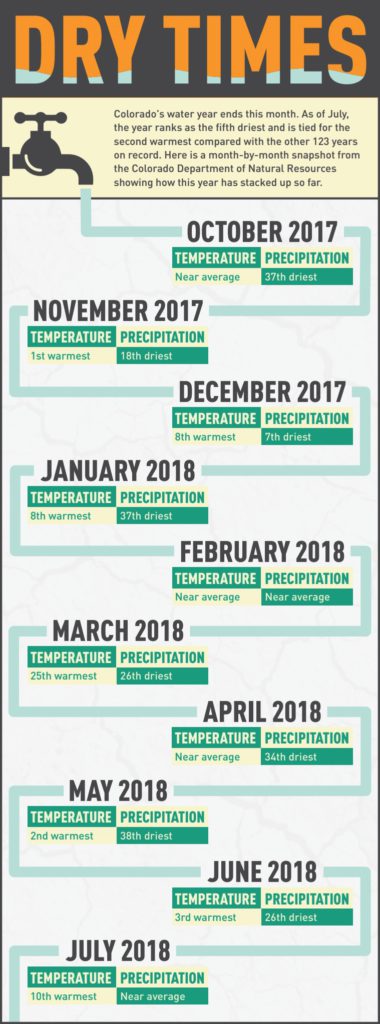

Almost all of Colorado is experiencing some level of drought this year, and depending on what part of the state you live in the conditions are severe.
With the final numbers still to be tallied after the end of September, the current Colorado water year — which runs from Oct. 1 to Sept. 30 — ranks as the fifth-driest and is tied for the second-warmest on record. “We’re dry in all parts of Colorado,” said Taryn Finnessey, senior state climatologist with Colorado Department of Natural Resources, of this year’s low precipitation levels. “Statewide, we’re safe to say it’s probably going to be in the top ten.”
Along the Front Range and in the northeast, drought conditions are relatively mild or near average. However, on the Western Slope and in the southwest part of the state, the drought is extreme and even exceptional, the highest rating as monitored by the National Oceanic and Atmospheric Administration. “In southwestern Colorado,” Finnessey said, “they’re on track to have their driest year on record, with record low streamflow and snowpack.” The conditions are worse in that area than in 2002, the previous dry year on record, Finnessey said.
In May, Gov. John Hickenlooper activated the state’s Drought Mitigation and Response Plan, which prompts the formation of a Drought Task Force and an Impact Task Force for agriculture to more closely monitor the conditions in specific areas. 
Cities such as Grand Junction and Aspen have instituted mandatory watering restrictions. Not surprisingly, Finnessey said, two significant fires have sparked this year in the dry southwest — the Burro Fire and the 416 Fire north of Durango.
Finnessey said she’s hesitant to attribute these conditions to any single factor, but that climate change has certainly played a role. “Drought is determined by precipitation, but when you warm things up, things get thirstier and regardless of the amount of precipitation, you need more water to meet those demands,” she said. “The fact that we have warmed 2 degrees in the last 30 years and 2.5 in the last 50, that’s a layer of how we are seeing things change in Colorado.”
Jim Pokrandt, director of community affairs for the Colorado River Water Conservation District, a state policy and planning agency for the Colorado River Basin, said this year does stands out but that it’s also another a dry year in an 18-year period of dry years. “Some in the water community are saying now maybe drought is the wrong word, maybe this is the new normal,” Pokrandt said. “Only in four of the last 18 years has there been above average snowpack — this year was the fourth worst on record.”
Nathan Elder, manager of raw water supply for Denver Water, said runoff peaked about a month earlier this year — mid-May instead of mid-June — which caused the agency to dip into its reserves sooner. Elder said Denver Water’s reserves are at about 89 percent, which is only slightly below a more normal 92 percent for this time of year. “A lot of our storage is still pretty decent because we’ve had good conservation from our customers,” he said.
Another pressing question on the minds of those in the Colorado water community is what type of weather will show up this fall.
A wet and snowy fall and early winter will help the state recover from this year’s drought; continued below average snowpack, however, will only compound the problem. “We’re really in wait and see mode,” Finnessey said. “Fall precipitation is really important for soil moisture.”
Brian Nazarenus, a water attorney with Ryley Carlock & Applewhite, said he isn’t overly concerned about the conditions along the Front Range at the moment, but that he’ll also be keeping a close eye on the weather during the next six months. “You don’t know what you don’t know, and the one thing you really don’t know is what the weather is going to do,” Nazarenus said.
He added, “If it’s a dry winter and we don’t get spring rains, then next year people will be on edge.”
— Chris Outcalt

